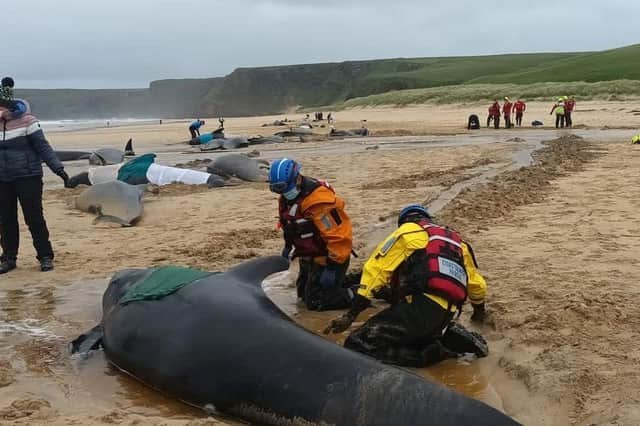‘No signal’ hits whale rescue co-ordination


Now they have issued a public appeal for new equipment that wil help prevent a repeat situation in remote areas where telecommunications are poor.
The British Divers’ Marine Life Rescue service were alerted to the mass stranding of pilot whales at Traigh Mhor Tolsta early last Sunday morning. Tragically, 54 of them died and only one was saved.
Advertisement
Hide AdAdvertisement
Hide AdPilot whales are known to be susceptible to mass stranding due to their highly sociable nature, particularly if a female is nearing labour, as all in the pod will follow. Due to the fact they are normally found in deep waters, they do not have a natural understanding of the movement of the tides near the shore.
The incident in Tolsta last Sunday is the worst lethal mass stranding in Scotland. While it was reported at 7.15am on the Sunday, by the time rescuers arrived only 15 were alive and although efforts were made to refloat them, with the coastguards and local vet, by 3.30pm only one had survived.
In 2011, a total of 70 whales were stranded in Durness on the other side of the Minch but most were refloated and only 19 died, while in Staffin in Skye, in 2015, 21 were washed ashore - but again 18 were refloated.
That makes last weekend’s incident all the more harrowing, due to the unsuccessful nature of the rescue attempt.
Advertisement
Hide AdAdvertisement
Hide AdIn a statement, the BDMLR said: “This was an incredibly complex rescue – the signal was extremely poor in such a remote area with our Medics often having to drive 1-5 miles to get service to communicate with Rescue Coordinators at Head Office.
“This rescue also made it clear that we need to purchase more VHF radios in order to improve communications in remote areas.”
BDMLR have now called for donations to help purchase equipment that will mean they are not reliant on the communications infrastructure in the more remote areas, which can sometimes be poor and non-existent.
Post mortems will be carried out to determine exactly the cause of death and maybe offer a scientific explanation as to why they became stranded at the head of Broad Bay.
Advertisement
Hide AdAdvertisement
Hide AdThe Scottish Marine Animal Stranding Scheme has appealed for spare freezer space on Lewis as the quantity of samples they are having to deal with is much larger than what would normally be the case.
Colin McFadyen, Scotland coordinator for BDMLR, said: “There was a very young calf on the beach and a female with a prolapsed womb.
“The assumption is that she was clearly in difficulty and the pod stayed in shallow waters helping her to stay afloat, essentially helping her to recover until either they were too tired to escape or the tide went out under them.”
He added: “Because they are deep sea animals, pilot whales don’t understand what beaches are and that the water can disappear.
Advertisement
Hide AdAdvertisement
Hide Ad“From what I’ve seen they do whatever they can to assist their podmates, but they don't necessarily know that by doing that they are putting themselves in lethal danger until the water goes away and they suddenly can't swim any more.
“It is absolutely a selfless act, but I don’t think it’s the suicidal act that we may think it is.”
Mr McFadyen also praised all the volunteers and local services who came to their assistance last Sunday.
Members of the community, Stornoway Coastguard, Stornoway and Shawbost Fire and Rescue, the Scottish Marine Animal Stranding Scheme, the Scottish SPCA, and Civil Air Support were all involved in the rescue effort, with other vets and marine experts being flown in to help.
Advertisement
Hide AdAdvertisement
Hide AdAs news of the incident spread, police issued a public warning for members of the public to stay away from the area.
Comhairle nan Eilean Siar environmental health services will now be responsible for the clean-up operation, with the carcasses having to be transported to infill. The costs are not known, but likely to be substantial.
A Comhairle spokesperson said: "The Comhairle has engaged with professionals and is now working with partner organisations to clear the beach."